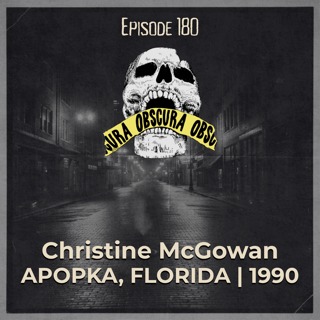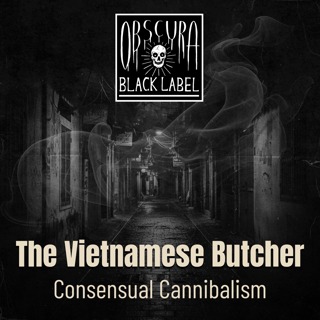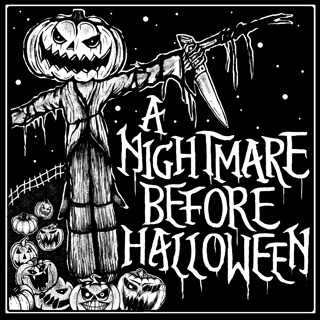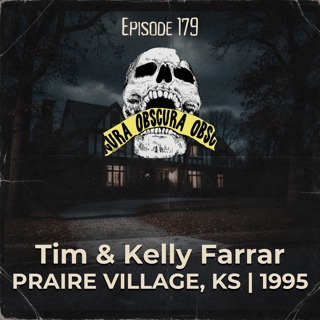
MURDERED: Christine McGowan | Apopka, Florida 1990
Apopka, Florida. October 30, 1990. When 10-year-old Christine McGowan's stepfather entered her bedroom to wake her for school—he found her lifeless body face down in bed, the sheets beneath her soaked in blood. The door to their home stood slightly ajar. His white construction truck—keys left in the ignition the night before—had vanished.Christine McGowan was a blonde-haired child who spent her afternoons watching her neighbor at The Lighthouse Mission halfway house craft decorative wooden boats. She stood in the autumn sun asking if she could watch him work, fascinated by his woodworking skill. She had no way of knowing that Elmer Leon Carroll—the seemingly harmless craftsman next door—was a twice-convicted child molester living under pastoral supervision. On the night of October 29, 1990, as an unseasonable cold front brought 40-degree temperatures and 45 mph winds to central Florida, Carroll's schizophrenic delusions reached a breaking point. Witnesses at Lockahart Tavern watched him drink beer after beer, wrapping his jacket around a chair and holding long conversations with it about demons, devils, and the coming apocalypse. Hours later, he entered the McGowan home through an unlocked door.This case exposes the catastrophic failures of Florida's 1990s halfway house system and sex offender monitoring. Carroll had served less than two years of a six-year sentence for child molestation, then served just over seven years for a second offense—both times released with minimal supervision directly into residential neighborhoods. The Lighthouse Mission placed a known predator with untreated severe mental illness next door to a family with a young daughter. The investigation moved swiftly—Carroll was apprehended within hours after stealing the family's truck—but the preventable nature of Christine's death haunted the community for years. Her case became a catalyst for examining how convicted sex offenders with documented psychiatric disorders were supervised after release.This episode contains detailed discussion of child sexual assault, graphic autopsy testimony, and descriptions of fatal violence against a child. This content may be disturbing. Listener discretion is strongly advised.Key Details:The Investigation: Wildlife officer Carl Young spotted Carroll walking on State Road 520 away from the stolen truck just hours after the murder. A box cutter, razor blade, and keys matching the stolen vehicle were found in his possession.Forensic Evidence: Medical examiner Dr. Thomas Hegert testified that Christine died from asphyxiation due to manual strangulation—a process taking 3-4 minutes during which she remained conscious for 1-2 minutes. The autopsy revealed severe sexual trauma and blunt force injury to her head.The Penalty Phase: The jury recommended death by unanimous 12-0 vote. Carroll was executed on May 29, 2013—nearly 23 years after Christine's murder. He refused to make a final statement and avoided eye contact with Christine's family members who watched him die.Resources: If you or someone you know has experienced childhood sexual abuse, the RAINN National Sexual Assault Hotline provides confidential 24/7 support at 1-800-656-HOPE (4673) or online at rainn.org. The Childhelp National Child Abuse Hotline offers crisis intervention and professional counseling at 1-800-422-4453.Credits: Research, writing, and narration by Justin Drown. Production and sound design by Justin Drown. This episode utilized court documents, medical examiner testimony, and contemporary news reporting from the Orlando Sentinel.Support Obscura: Join our community at patreon.com/obscurapodcast for ad-free episodes, extended cuts, and exclusive Black Label cases. Visit mythsandmalice.com/show/obscura for full episode archive and case resources.Our Sponsors:* Check out Chime: https://chime.com/OBSCURA* Check out Kensington Publishing: https://www.kensingtonbooks.com* Check out Mood and use my code OBSCURA for a great deal: https://mood.com* Check out Progressive: https://www.progressive.comSupport this podcast at — https://redcircle.com/obscura-a-true-crime-podcast/exclusive-contentAdvertising Inquiries: https://redcircle.com/brandsPrivacy & Opt-Out: https://redcircle.com/privacy
4 Nov 23min

BLACK LABEL: The Vietnamese Butcher | Consensual Cannibalism in Vietnam 2025
EXTREME CONTENT WARNING: This BLACK LABEL episode contains graphic descriptions of consensual cannibalism, extreme sexual fetish, and disturbing audio recordings. This content is rated 10/10 for intensity.In January 2025, a video surfaced on dark web forums and Telegram channels that shocked even the most hardened true crime observers. Unlike staged "snuff films" or horror fiction, this footage documented something unprecedented: the first authenticated case of consensual cannibalism captured on film and distributed publicly. The victim, Nguyen Xuan Dat, a Vietnamese man from Hadong, had spent years openly advertising his extreme fetish—he desperately wanted to be decapitated.For years, Nguyen frequented extreme pornography websites and fetish forums under aliases like "Dat Beheading," posting repeatedly about his desire for execution. His Facebook biography read: "Likes to be decapitated." He wrote: "I'm looking for my executioner." What began as consumption of guro pornography—animated extreme violence—escalated into an obsessive fantasy about his own death. Nguyen suffered from severe physical health issues that left him dependent on his parents, working occasionally at a fish market. In leaked messages, he described himself as "a prisoner of my own body," and expressed that if not for his Catholic faith, he would have ended his life long ago.Between January 25 and February 24, 2025, Nguyen's fantasy became reality. The resulting footage—filmed from multiple camera angles—was distributed through underground channels where users share content featuring necrophilia, drugged rape, and extreme violence. The videos show Nguyen participating willingly in his own execution and dismemberment, with evidence suggesting cannibalization of his remains. This case represents only the third confirmed instance of consensual homicide motivated by mutual sexual gratification—and the first where the video evidence leaked to the public.The two previous cases occurred in Germany. In 2001, Armin Meiwes—the "Rotenburg Cannibal"—killed and consumed engineer Bernd Brandes after meeting him on the Cannibal Café forum. Meiwes filmed the four-hour killing, but that footage remained sealed as evidence. In 2013, former police officer Detlev Guenzel found his willing victim on the website Zambian Meat, filming a 50-minute dismemberment video that also never leaked publicly. The Vietnamese case shattered this precedent—making it the world's first authentic "snuff film" to enter public circulation.The footage reveals disturbing details: distinctive floor tiles, meat cleaver brands, and chopsticks laid beside prepared human flesh. Internet investigators have traced regional Vietnamese accents and identified tattoos proving the same participants appear throughout multiple videos. Eleven clips and 98 photos were sold as a commercial package on dark web marketplaces and Telegram channels, suggesting profit motive alongside the sexual gratification.This BLACK LABEL episode presents the complete investigation with unflinching forensic detail, explores the psychology behind extreme sadomasochistic fetishes, and examines the dark web's role in facilitating consensual death. Justin includes authentic audio from the investigation and analyzes how internet communities enable these fatal encounters.This is BLACK LABEL content—complete, uncensored, and uncompromising.Access this episode:Patreon BLACK LABEL Tier ($25/month): patreon.com/obscurecrimepodcastApple Podcasts Premium BLACK LABEL ChannelRedCircle Exclusive ContentResources:National Suicide Prevention Lifeline: 988Crisis Text Line: Text HOME to 741741Our Sponsors:* Check out Chime: https://chime.com/OBSCURA* Check out Kensington Publishing: https://www.kensingtonbooks.com* Check out Mood and use my code OBSCURA for a great deal: https://mood.com* Check out Progressive: https://www.progressive.comSupport this podcast at — https://redcircle.com/obscura-a-true-crime-podcast/exclusive-contentAdvertising Inquiries: https://redcircle.com/brandsPrivacy & Opt-Out: https://redcircle.com/privacy
28 Okt 24min

Black Label + Halloween Specials
In January 2025, Nguyen Dat, a 35-year-old Vietnamese man living in Ha Dong, voluntarily sought his own execution—fulfilling a years-long sexual obsession with decapitation. Through extreme pornography forums and dating apps, Nguyen publicly advertised his desire to be beheaded, eventually connecting with an unnamed butcher who shared his fatal fetish.The killing occurred between January 25 and February 24, 2025, in a makeshift execution chamber. Graphic video footage—leaked to Vietnamese and Chinese Telegram groups—shows Nguyen's decapitation as he reached sexual climax. The butcher then dismembered his body with professional precision, documenting the process across 11 videos and 98 photographs. Evidence suggests the killer cannibalized Nguyen's remains, cooking parts of his body into Vietnamese dishes. When concerned citizens reported the leaked footage to authorities, they discovered Nguyen had been missing for five years.This case represents only the third confirmed consensual homicide motivated by mutual sexual gratification—and the first where execution footage was publicly leaked. Obscura examines this disturbing intersection of extreme fetishism, voluntary death, and the dark corners of online subcultures where such transactions occur.[BLACK LABEL CONTENT WARNING: This episode contains extremely graphic descriptions of violence, dismemberment, and cannibalism.]Explore more obscure true crime cases at mythsandmalice.com/show/obscura. Join Obscura on Patreon to unlock the entire back catalogue ad-free, plus exclusive Black Label premium episodes—darker, longer cases released monthly. Dive deeper into the cases mainstream media forgot.KEYWORDS: true crime, true crime podcast, Nguyen Dat, Vietnam crime, consensual homicide, voluntary execution, cannibalism case, Ha Dong Vietnam, decapitation, dismemberment, sexual homicide, extreme fetish, guro, murder case, Armin Meiwes, Zambian Meat case, 2025 crime, obscure true crimeOur Sponsors:* Check out Chime: https://chime.com/OBSCURA* Check out Kensington Publishing: https://www.kensingtonbooks.com* Check out Mood and use my code OBSCURA for a great deal: https://mood.com* Check out Progressive: https://www.progressive.comSupport this podcast at — https://redcircle.com/obscura-a-true-crime-podcast/exclusive-contentAdvertising Inquiries: https://redcircle.com/brandsPrivacy & Opt-Out: https://redcircle.com/privacy
28 Okt 5h 7min

MURDERED: Timothy & Kelly Farrar | Prairie Village, Kansas 1995v
On October 24, 1995, firefighters battled a massive blaze at a Tudor-style home in Prairie Village, Kansas. Thirteen-year-old Timothy Farrar and his six-year-old sister Kelly died in the inferno while their ten-year-old sister Kate escaped by jumping from a second-floor window. Within hours, investigators determined the fire had been deliberately set with multiple gallons of accelerant poured throughout the house—and the trail of evidence led directly to the children's own mother.Part 2 of 2.Dr. Debora Green was a practicing oncologist with a medical degree and a history of psychiatric hospitalizations. Her marriage to cardiologist Dr. Michael Farrar had deteriorated rapidly in 1995 as Michael pursued divorce. But the house fire represented only part of her crimes. For months leading up to October, Michael had suffered mysterious illnesses requiring multiple hospitalizations. Doctors initially misdiagnosed bacterial endocarditis as his weight plummeted to 125 pounds. Investigators would later discover Debora had been systematically poisoning him with ricin—one of the deadliest toxins known—extracted from castor beans she purchased from local garden centers.The fire investigation revealed chilling evidence of premeditation. Between three and ten gallons of liquid accelerant had been poured throughout the home's main floor, second floor, and basement, creating multiple points of origin. The pour patterns stopped precisely at the master bedroom door—where Debora slept. The accelerant blocked the main stairway, trapping Timothy and Kelly on the second floor. When Kate woke to smoke and flames, she climbed through her bedroom window onto the garage roof and jumped. Timothy, following his mother's instructions via intercom to stay in his room and wait for firefighters, never escaped. His body was found where it had fallen through the burned flooring.Kelly died of smoke inhalation in her bed, still curled in a sleeping position. The family's dog Boomer was found in her room, also a victim of the fire. Investigators recovered Timothy's and Kelly's bodies the morning after the blaze once the structure was deemed safe to enter.Debora's behavior immediately after the fire raised investigators' suspicions. She arrived at a neighbor's door with wet hair asking them to call 911, despite claiming she had not been near water or flames. During police interviews hours later, she appeared "talkative, even cheerful" and repeatedly referred to Timothy and Kelly in the past tense while they were officially still missing. She provided conflicting accounts of the evening's timeline and seemed uncertain about basic facts.On November 22, 1995, police arrested Debora at a Kansas City theater where she had dropped Kate off for ballet practice. She was charged with two counts of capital murder, two counts of attempted first-degree murder, and aggravated arson. On April 17, 1996, she entered an Alford plea—maintaining her innocence while acknowledging prosecutors had sufficient evidence for conviction. The plea removed the death penalty from consideration.Judge sentenced Debora to two concurrent "Hard 40" life sentences—forty years without possibility of parole. Multiple psychiatric evaluations revealed complex mental health disorders including schizoid personality disorder, with later clinicians identifying traits of psychopathy, borderline personality disorder, and narcissistic personality disorder. Debora filed multiple appeals based on claims of incompetency and advances in fire science, but all were denied.She remains incarcerated at Topeka Correctional Facility in Kansas with an earliest possible release date of November 21, 2035, when she will be 84 years old.Content WarningThis episode contains discussion of child deaths, arson, poisoning, and domestic violence.Key Episode DetailsFire investigation methodology: Multiple points of origin, accelerant pour patterns, basement stagingRicin poisoning evidence: Castor bean purchases, FBI antibody testing, Michael's medical recordsAlford plea mechanics: Legal strategy allowing innocence claim while accepting convictionResources & Victim AdvocacyNational Domestic Violence Hotline: 1-800-799-7233 | thehotline.orgNational Child Traumatic Stress Network: nctsn.orgFire survivor resources: Phoenix Society for Burn Survivors | phoenix-society.orgSupport ObscuraJoin our Patreon community for bonus episodes, early access, and ad-free listening at https://www.patreon.com/obscuracrimepodcast/Our Sponsors:* Check out Chime: https://chime.com/OBSCURA* Check out Kensington Publishing: https://www.kensingtonbooks.com* Check out Mood and use my code OBSCURA for a great deal: https://mood.com* Check out Progressive: https://www.progressive.comSupport this podcast at — https://redcircle.com/obscura-a-true-crime-podcast/exclusive-contentAdvertising Inquiries: https://redcircle.com/brandsPrivacy & Opt-Out: https://redcircle.com/privacy
22 Okt 32min

MURDERED: Tim & Kelly Farrar | Prairie Village, Kansas 1995
On the windy night of October 23, 1995, Dr. Debora Green's three children—thirteen-year-old Tim, ten-year-old Kate, and six-year-old Kelly—went to bed in their beautiful new home on Canterbury Court in Prairie Village, Kansas. By 12:20 AM on October 24, their lives would be forever shattered by a fire that investigators would later determine was no accident.Part 1 of 2The Perfect Life, UnravelingDebora Green seemed to have everything. Born Debora Jones in 1951, she possessed a genius-level IQ of 165, excelled academically, and graduated from the University of Kansas School of Medicine in 1975. She married cardiologist Dr. Michael Farrar in 1979, and together they built what appeared to be an enviable life: successful medical practices, three bright children, and an opulent home in an exclusive Kansas City suburb. But beneath the surface, the marriage was crumbling under the weight of Debora's volatile temper, heavy drinking, and Michael's emotional withdrawal.By the summer of 1995, Michael had moved out and filed for divorce. Between August and September, he experienced repeated bouts of mysterious, severe gastrointestinal illness that hospitalized him three times. Despite extensive testing, doctors couldn't determine the cause of his symptoms. What Michael didn't know was that Debora had discovered a deadly secret: ricin, a naturally occurring poison extracted from castor beans—and she was serving it to him in his food.The FireWhen firefighters arrived at 7517 Canterbury Court in the early morning hours of October 24, they found Debora and Kate outside the burning home. Tim and Kelly were still inside. Despite heroic efforts by first responders, Tim succumbed to severe burns and Kelly died from smoke inhalation. Kate had escaped by climbing onto the garage roof and jumping to safety. Investigators immediately noticed something disturbing: Debora appeared eerily calm as her children burned to death inside.Arson investigators quickly determined the fire was no accident. Trails of accelerant led directly back to Debora's bedroom, and forensic evidence suggested she had deliberately cut off the children's escape routes. The investigation expanded when police connected Michael's mysterious illness to castor beans found in Debora's purse during a September domestic disturbance call. Toxicology tests revealed ricin antibodies in Michael's blood.This Is Part 1This episode covers Debora Green's early life, her marriages, the deterioration of her relationship with Michael Farrar, and the events leading up to the October 1995 fire. Part 2 will examine the investigation, Debora's arrest and trial, and the aftermath of this unthinkable crime.Primary Source: This episode draws extensively from Ann Rule's authoritative 1997 book Bitter Harvest: A Woman's Fury, A Mother's Sacrifice, along with court documents, news archives, and forensic reports from the Johnson County investigation.Resources:If you or someone you know is experiencing domestic violence, contact the National Domestic Violence Hotline at 1-800-799-7233 or visit thehotline.org.Join the Patreon: For hundreds of hours of bonus episodes, Black Label content, and ad-free listening, visit patreon.com/obscuraacrimepodcastConnect: Follow Obscura on Instagram @obscuraacrimepodcastOur Sponsors:* Check out Chime: https://chime.com/OBSCURA* Check out Kensington Publishing: https://www.kensingtonbooks.com* Check out Mood and use my code OBSCURA for a great deal: https://mood.com* Check out Progressive: https://www.progressive.comSupport this podcast at — https://redcircle.com/obscura-a-true-crime-podcast/exclusive-contentAdvertising Inquiries: https://redcircle.com/brandsPrivacy & Opt-Out: https://redcircle.com/privacy
15 Okt 29min

TRAGEDY: Five Nurses Die in Limousine Fire | San Mateo Bridge, California 2013
On May 4, 2013, nine nurses celebrating a bachelorette party crossed the San Mateo-Hayward Bridge in a white stretch limousine. At 10:07 PM, thick black smoke began rising from the floor. Within minutes, the rear compartment was engulfed in flames. Four women and the driver escaped. Five women—including bride-to-be Neriza Fojas—remained trapped inside.This episode features real 911 calls from witnesses and survivors, testimony describing desperate escape attempts through a 3-foot partition window, and the complete investigation findings. California Highway Patrol investigators concluded the fire resulted from catastrophic suspension failure, not the airbag rupture initially reported by media.Listen on Obscura wherever you get podcasts. For extended content and ad-free episodes, join t.Content Warning: This episode contains graphic 911 audio, survivor testimony describing entrapment, and discussions of burn injuries.THE CASEOn the evening of May 4, 2013, Neriza Fojas—a 31-year-old nurse from Monterey, California—celebrated her recent wedding with eight close friends. All nine women worked together as nurses at healthcare facilities in the Bay Area. They had rented a white stretch limousine from Limo Stop, a San Jose company, to transport them to a bridal shower celebration in Foster City.At approximately 10:00 PM, the 1999 Lincoln Town Car limousine began crossing the San Mateo-Hayward Bridge westbound toward the peninsula. Driver Orville "Ricky" Brown, 46, piloted the vehicle while the women celebrated in the rear passenger compartment behind a raised privacy partition.THE FIREAt 10:07 PM, one of the passengers knocked on the partition and said "smoke." Brown initially believed she was asking permission to smoke a cigarette and told her to wait a few minutes. Then he felt bumps beneath the vehicle. Thick, black, acrid smoke began rising from the floor of the passenger compartment. Within seconds, the rear of the limousine was engulfed in flames.Brown pulled onto the right shoulder near the bridge's high rise section. Emergency calls flooded 911 dispatch. "We need help on the San Mateo Bridge," a woman screamed. "Oh my God, oh my God. I cannot open the door."Four women managed to escape through the narrow partition window separating the driver's compartment from the passenger area—a space measuring approximately 3 feet by 1.5 feet. Survivors described pulling each other through the opening, with some becoming stuck at the hips. Amalia Loyola was the last to escape, suffering severe burns to her ankles as flames consumed the rear compartment.Five women remained trapped: Neriza Fojas (31), Michelle Estrera (35), Jennifer Balon (39), Anna Alcantara (46), and Felomina Geronga (43). All five died from smoke inhalation and thermal injuries. When firefighters extinguished the blaze, they found the victims near the partition window—their final desperate attempt to reach safety.THE INVESTIGATIONCalifornia Highway Patrol investigators and the Foster City Fire Department conducted an exhaustive examination of the vehicle, maintenance records, and witness testimony. Their conclusion: the fire was accidental.The catastrophic failure of the limousine's rear suspension system allowed the rapidly spinning driveshaft to make contact with the floor pan. The friction created sparks and intense heat, igniting the vehicle's interior. Contrary to initial media reports, investigators found no evidence of ruptured air suspension bags or the vehicle's undercarriage scraping the roadway.Additional factors contributed to the tragedy: the limousine was overloaded with nine passengers despite being rated for seven, and the raised privacy partition prevented effective communication about the emergency. Driver Brown was cleared of wrongdoing after cell phone records confirmed he was not on his phone during the incident.Four survivors and the families of the five deceased women filed wrongful death lawsuits against Ford Motor Company, Limo Stop, and Accubuilt (the company that converted the vehicle). Most cases settled out of court. A jury later found Ford not liable, determining Limo Stop's improper maintenance was responsible.THIS EPISODEThis Obscura investigation features real 911 calls from the night of the fire, survivor testimony from subsequent legal proceedings, and official investigation findings from California Highway Patrol. The episode examines how a joyful celebration became a preventable tragedy through mechanical failure and regulatory gaps in the limousine industry.RESOURCESNational Burn Victim Foundation: www.nbvf.orgCalifornia Highway Patrol Vehicle Safety: www.chp.ca.govOur Sponsors:* Check out Chime: https://chime.com/OBSCURA* Check out Kensington Publishing: https://www.kensingtonbooks.com* Check out Mood and use my code OBSCURA for a great deal: https://mood.com* Check out Progressive: https://www.progressive.comSupport this podcast at — https://redcircle.com/obscura-a-true-crime-podcast/exclusive-contentAdvertising Inquiries: https://redcircle.com/brandsPrivacy & Opt-Out: https://redcircle.com/privacy
9 Okt 17min

176: The Turbulent Life and Death of Kelsey Hildal - Part 02
In the conclusion of this two-part series, Obscura turns from the formative years of Kelsey A. to her final, devastating night.On April 1st, 2025, calls began flooding into dispatch: a wrong-way driver on Interstate 275. Officers pursued a gray Ford Escape, ultimately forcing it to a stop. What unfolded in the following minutes was chaos, fear, and tragedy—ending with gunfire that would claim Kelsey’s life.Part 2 captures the raw audio from the dash cams, radios, and body mics that recorded her final moments. Beyond the incident itself, we examine the aftershock: the grief of her family, the official investigation, and the long shadow of untreated mental illness that had haunted her for years.This episode is not only about what happened on that highway—it’s about how a life shaped by hardship, resilience, and trauma reached its breaking point.What You’ll Hear in This EpisodeEmergency calls describing a wrong-way driver on I-275.Police radio and dash cam audio from the pursuit and confrontation.Kelsey’s final words, captured in tense exchanges with officers.First-hand accounts of officers securing the scene and her dog.News reports and witness perspectives on the officer-involved shooting.The moment her family was notified and their reflections on her struggles.Insights into the paranoia, fear, and mental health battles that consumed Kelsey in her final year.Content WarningThis episode contains graphic audio of a police shooting, discussions of mental illness, and descriptions of death. Listener discretion is strongly advised.Closing NotePart 2 closes the story of Kelsey’s life—a life marked by resilience and collapse, triumph and tragedy. Thank you for sitting with her story.Our Sponsors:* Check out Chime: https://chime.com/OBSCURA* Check out Kensington Publishing: https://www.kensingtonbooks.com* Check out Mood and use my code OBSCURA for a great deal: https://mood.com* Check out Progressive: https://www.progressive.comSupport this podcast at — https://redcircle.com/obscura-a-true-crime-podcast/exclusive-contentAdvertising Inquiries: https://redcircle.com/brandsPrivacy & Opt-Out: https://redcircle.com/privacy
30 Sep 20min

175: The Turbulent Life and Death of Kelsey Hildal - Part 01
In this first part of a two-part series, Obscura takes you inside the complicated and often tragic life of Kelsey A., a young woman whose story weaves together resilience, trauma, and the weight of circumstance.From her early struggles with brain surgery and a near-fatal car accident to her years in a bootcamp and boarding school, Kelsey’s life was shaped by events that altered her path in profound ways. Despite it all, she rose as a standout athlete—first on the basketball court, then in the MMA cage. But as the years went on, new battles emerged: psychiatric crises, brushes with the law, and the dark pull of choices made in desperation.Part 1 is not the story of her final day—it is the story of how she got there. By tracing her journey, we see the psychological weight she carried and the brief moments of triumph that stood out against a backdrop of adversity.This episode lays the foundation. Part 2 will plunge into the darker, more unsettling details of her final chapter.What You’ll Hear in This EpisodeKelsey’s early life in Cincinnati and the medical ordeal that reshaped her childhood.A devastating car accident that left lasting physical and psychological scars.Her removal from home and placement into a North Carolina bootcamp, followed by Montana Academy.Near-death experiences, including her survival after collapsing in the snow during an escape attempt.The drive and talent that turned her into a star basketball player and later an MMA fighter.Glimpses of her later years: psychiatric struggles, brushes with law enforcement, and choices that complicated her legacy.A reflection on how chance, trauma, and resilience shaped the person Kelsey became.Content WarningThis episode contains discussions of brain trauma, psychiatric crises, sex work, and law enforcement encounters. Listener discretion is advised.Closing NotePart 1 sets the stage. Part 2 will take you deeper into the grittier, unsettling details that define Kelsey’s final years. Free listeners will get Part 2 next week; patrons can listen early.Our Sponsors:* Check out Chime: https://chime.com/OBSCURA* Check out Kensington Publishing: https://www.kensingtonbooks.com* Check out Mood and use my code OBSCURA for a great deal: https://mood.com* Check out Progressive: https://www.progressive.comSupport this podcast at — https://redcircle.com/obscura-a-true-crime-podcast/exclusive-contentAdvertising Inquiries: https://redcircle.com/brandsPrivacy & Opt-Out: https://redcircle.com/privacy
25 Sep 20min






















